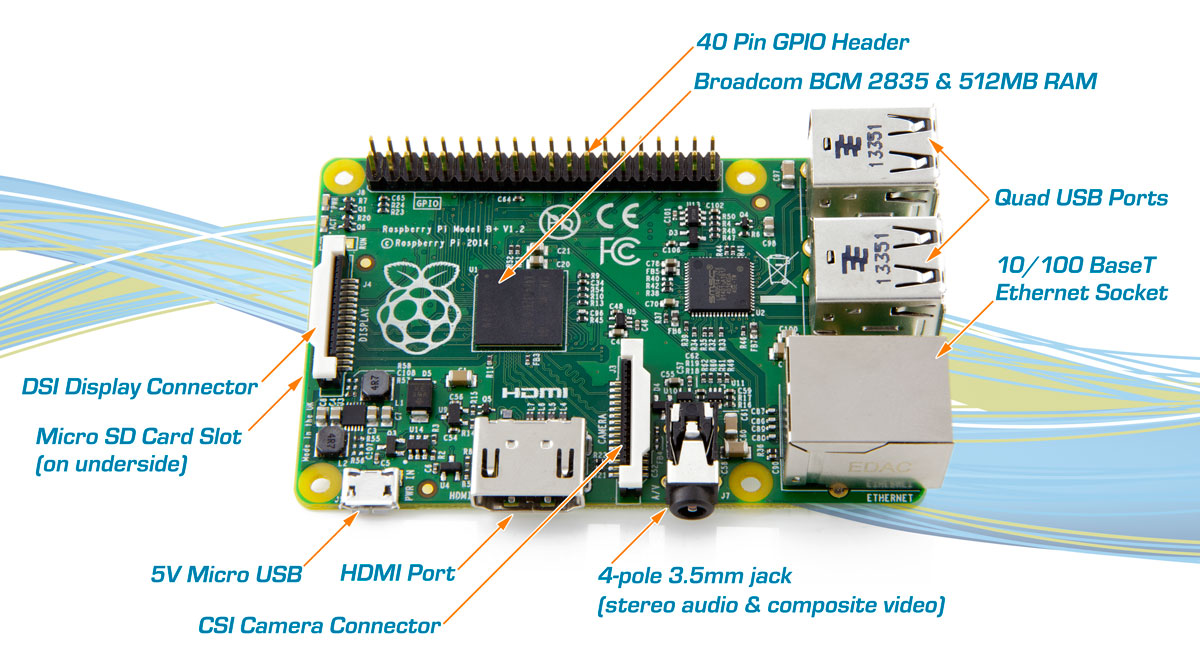Innovating with the Raspberry Pi B+
The Raspberry Pi B+, launched earlier this year, can be seen as the next evolution to the Raspberry Pi board and is stacked with interesting new features, adding even more functionality and possibilities to designers, innovators and engineers. By Andy Laing, Raspberry Pi Global Product Manager, element14.
The GPIO header on the Raspberry Pi B+ has grown to 40 pins, while retaining the same pinout for the first 26 pins as the B Model. Furthermore, it has four USB 2.0 ports rather than two adding connectivity as well as better hotplug and overcurrent behaviour. The old friction-fit SD card socket has been replaced with a push-push micro SD version. The new board also features lower power consumption – by between 0.5 and 1W. The audio circuit incorporates a dedicated low-noise power supply, resulting in better audio quality. Finally, thanks to a neater form factor, the new board features four squarely-placed mounting holes.
In order to find out how the Raspberry Pi B+ will be used by engineers to enhance their designs and explore new design methods, we asked our 250,000 strong element14 Community to submit their project ideas. We saw a plethora of new, exciting ideas that applied to an extremely diverse range of industries pitched at every audience from parents and consumers to industrialists and technologists.
From the roads to the skies
The low-power credentials of the latest version of the Raspberry Pi board lend it well to use in industries such as the automotive, climate and energy industries – industries that are constantly looking to achieve higher levels of performance while consuming less power. One of the winning ideas coming out of the element14 Community Challenge was a black box system for cars, combining the Raspberry Pi B+ with a speedometer, accelerator and break sensors, collision sensor and engine temperature sensor. Integrating the Raspberry Pi B+ into this design would result in a lower-cost product, which can support low-power consumption – an ideal scenario for automotive engineers.
The climate/energy applications saw lots of strong ideas, two of which stood out in particular. The first suggested that the Raspberry Pi B+ could be combined with TDS (Total Dissolved Solids) and other water pollution sensors to create a River Water Pollution Monitoring System. Once collected, this data would be sent to Plotly, an online data sharing tool, where it could be analysed. The second ideas involved using the Raspberry Pi B+ to collect, analyse and broadcast data for a homemade weather station. This would be a fun and educational experience for students in this field. In both instances, the Raspberry Pi B+ allows innovators to experiment with more flexible design processes, meaning they are more likely to produce a resilient product that can withstand detrimental climatic conditions and remain low-cost.

Connecting the world
The higher number of USB 2.0 ports of the Raspberry Pi B+ board increases its connectivity capabilities, meaning innovators can experiment with designs requiring more advanced forms of connectivity. One of the areas this enhanced capability is of particular interest is the smart home market; a market Juniper Research predicts will be worth $71bn by 2018. The best idea we saw applied to this space was to use the Raspberry Pi B+ to restore and convert an antique bakelite telephone into an interactive community smartphone. Aimed at tech-savvy consumers, this project looks to take advantage of nostalgia towards ‘legacy technology’ by adding all the benefits of modern communication technologies.
One of the most exciting areas of technology where lots of innovation is taking place is robotics. To achieve a level of autonomy where robotic machines are capable of near human-like activities, designs must cater for high levels of connectivity, communication and processing power. The most exciting idea we saw for a robotics project was to build a robotic arm that processes Open CV (Open Source Computer Vision) and uses facial tracking and recognition, along with object tracking, to complete various tasks.
Making life easier
Lots of the innovative ideas we see inspired by the Raspberry Pi target the education and medical technology markets – projects that are designed to make living and learning a more practical experience for children, people with disabilities and those suffering from medical conditions. The mHealth market is forecast to be valued at around $6.7bn by the end of 2014. So, we were unsurprised to see a project idea, which looked to take advantage of the Raspberry Pi B+’s low power and additional IOs, to develop a device that integrates with a mobile phone, converting voice to braille for the deaf-blind. As the trend of using smartphone applications and wearable devices as a means of monitoring health and wellness continues to grow, development boards such as the Raspberry Pi B+ will inspire more devices designed to make gathering and analysing medical information using mobile devices more sophisticated.
Furthermore, another excellent use-case for the Raspberry Pi B+ generated from the element14 Community Challenge was for a digital kiosk for a school lobby, which would display upcoming events and timetables, helping students organise their schedules.
In summary, the launch of the Raspberry Pi B+ this year has been greeted with great enthusiasm from the engineering and design community. If we see even a few of the many ideas we’ve seen come to fruition, the updated board stands to help drive innovation in industries such as: automotive, robotics, medical technology, smart home, energy, education, robotics and many more.










